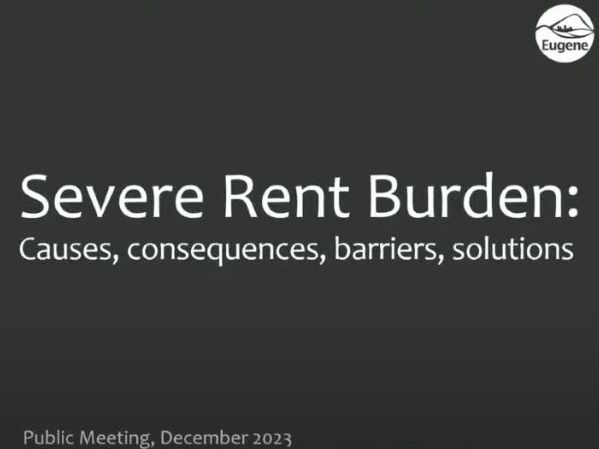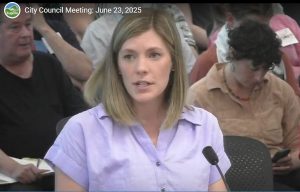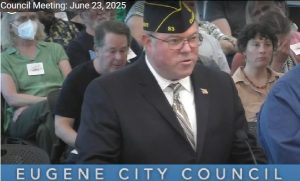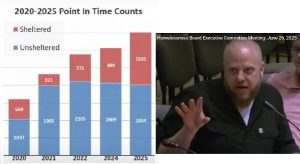‘Severely rent-burdened’ Eugene doubles housing production targets
7 min read
Thirty-one percent of Eugene renters are paying more than half of their income for rent and utilities. As required since 2018 by House Bill 4006, Eugene conducted a public meeting on the causes of severe rent burden, barriers, and possible solutions.
The primary cause: The city’s planning efforts fell short. At the Planning Commission Dec. 12:
Terri Harding (Eugene Planning): I’m Terri Harding…In Oregon, cities are guided by a statewide planning program where every community has an urban growth boundary and a comprehensive plan that implements the statewide planning goals. Goal Number 10 is the statewide goal that covers housing, and it requires all cities to plan for and accommodate a diversity of quality, affordable housing for all community members. However, we have not lived up to this standard, as the entire state is experiencing a housing crisis, with Eugene being one of the most rent-burdened communities statewide. The goal is to make it possible for people at all income levels to afford a place to live in the community that they choose.
[00:01:08] Amber Friedman (City housing analyst): I’m Amber Friedman, the city’s housing implementation pipeline analyst. Eugene is a severely rent-burdened city. Thirty-one percent of our Eugene population are severely rent-burdened. That’s when a household spends more than 50 percent of their income on rent and utilities, so over half of their income.
[00:01:28] So why is rent burden so high in Eugene? There’s the supply and demand perspective. Only about 2.9% of Eugene rental units are vacant. There just aren’t a lot of rental units available, making for a competitive market and leading to high rent.
[00:01:46] This is not unique to Eugene. Decades of housing underproduction in Oregon has left the whole state with a shortage of 140,000 housing units compared to what is needed to house our communities.
[00:02:01] Rent is high. The average rent in Eugene is $1,287 a month, which is about $250 more than neighboring rentals in Springfield. According to census data, the median household income in Eugene is $55,776 a year. The cost of living, a four-person family would need about $86,000 annual salary to afford to live in Lane County, which equates to $41.30 an hour.
[00:02:34] So why do we care if Eugene is a severe rent-burdened city? There’s negative economic outcomes, so people have less disposable income to spend in the local economy, people have less savings in the bank for unexpected expenses, and they’re at increased risk of experiencing homelessness because of it.
[00:02:55] It stifles generational wealth building. One of the primary ways people build generational wealth is through home ownership. And when they spend the bulk of their income on rent, there’s not much left over for buying a home.
[00:03:10] And this is particularly concerning because it perpetuates the already systemic and existing racial wealth gap as Black, Indigenous, and people of color are statistically less likely to own homes due to historic racist policies and practices.
[00:03:26] Individuals can’t afford to pay rent—moving in with friends and family, moving to a lower-cost area can result in crowding and displacement. Folks that move to lower-cost areas may have a longer commute to work or school, health care, grocery stores and makes it so they’re contributing less to their personal time and more carbon emissions from driving more cars on the road, causing traffic and more parking congestion,
[00:03:54] And severe rent burden can include negative health outcomes. Having less money due to housing costs can lead to sacrificing necessities like health care and nutritious food.
[00:04:06] When people are rent-burdened, they may give up other basic needs like child care, internet access, and transportation in order to pay rent. So, lots of causes and consequences.
[00:04:17] You may be wondering: Why haven’t we solved this problem yet? One of the main strategies for reducing rent burden is housing production. And the city of Eugene doesn’t actually build housing. It supports programs and projects that do with funding and other resources, but nonprofit and private developers are the ones doing the development and construction.
[00:04:40] Unfortunately, they face a number of barriers related to housing production. Some of these include cost and availability of lands and materials, construction labor costs, city permit costs and system development charges…
[00:04:54] There’s increasing inflation, high interest rates, and supply chain demands that are proving to negatively impact the likelihood that developers of all scales and sizes can produce building in pace with our need. And we’ve also seen a decline in federal investments in housing.
[00:05:14] There are solutions. In the short term, the city’s renter protections and tenant support programs work to keep folks in their homes and housing whenever possible.
[00:05:25] The city’s overarching long-term strategy is increasing overall supplies of housing and targeting investments to affordable housing. We do that through a myriad of programs and organize our work using an internal cross-departmental five-year work plan called the ‘housing implementation pipeline (HIP).’
[00:05:45] Having this work plan helps us coordinate current and future city resources, goals, and priorities across the full continuum of housing. So, all the way from people experiencing homelessness to overall housing supply and market rate housing.
[00:06:00] Some of the strategies used by the HIP include reducing system development charges for affordable housing projects that incentivize construction, property tax breaks for building low-income housing or multi-unit housing in specific areas of Eugene, a land acquisition program where the city identifies and acquires land that would be suitable for affordable housing projects.
[00:06:24] And a fun newer addition to this list is the pre-approved accessory dwelling units plan library.
[00:06:31] John Q: Rental Housing Navigator Amy Cameron described the renter protection program. Climate Policy Analyst Danielle Klinkebiel pointed out many renters are also energy-burdened. With long-term planning efforts:
[00:06:46] Heather O’Donnell (Eugene Planning): So this next round of work kicking off in 2024, phase two of the comprehensive plan will support the new housing production strategy and housing capacity analysis. It will also include a parcel-specific land use map…
[00:07:02] The housing capacity analysis is…really technical, but it’s important because it determines if Eugene has enough land in the urban area to meet the projected housing needs for the next 20 years. Having enough land for the needed housing units is important to reducing the cost of housing.
[00:07:25] The state now requires that the city do this every eight years. So that’s a new requirement…The state’s new rules, the Oregon Housing Needs Analysis (or the OHNA) are different from those that have been in place for decades, in part because they will include how much housing is needed to address the previous years of Eugene’s underproduction of housing that exists in the community, as well as to address people experiencing homelessness.
[00:07:57] So this will result in planning for about 30,000 new housing units, which is about two times more than what we planned for in the past. And so this is a big shift and we’re hopeful that it will result in a significant increase in Eugene’s housing supply in general.
[00:08:20] Leah Rausch (Eugene Planning): The housing production strategy will be a community-wide effort to inventory what we’re already doing, how well it’s working… We’ll also be required to monitor our progress, capturing the number of units that are produced, how we’re implementing those policies, and how effective they are…
[00:08:35] The state of Oregon gave us a crowdsourced resource that looks at over 100 housing tools. One of the big takeaways for me was that we’re already doing a lot in Eugene. We’re doing more than half of the 100 suggested strategies, at least in some capacity. But we know there’s more we can do…
[00:08:54] We know the permitting and the regulatory process can also pose a barrier by slowing down the production of housing or making excessive requirements that drive up costs.
[00:09:04] So the HPS (Housing Production Strategy) might include things like allowing for single room occupancies in residential zones… provide financial incentives, tax exemption, and abatement programs; provide direct financial resources and investments; and the City already taps into state and federal programs to provide funding for housing projects.
[00:09:24] The City can also continue to seek out land and partnerships to unlock development potential and lower the costs of future development.
[00:09:32] In early 2024, we’ll be launching a multi-project public involvement effort. We’ll be coming back to Planning Commission on the climate-friendly areas work in January and the proposed public involvement plan for urban growth strategies in February.
[00:09:50] Jason Lear (Planning Commission): That was a great presentation. I’ve always been kind of curious about examining ways to reconsider deed restrictions, which are a significant impetus to development, and I haven’t heard the idea mentioned very much, so I just thought maybe this is a forum to throw it out in, see if that’s any possibility in the future.
[00:10:11] Terri Harding (Eugene Planning): At times, state laws are passed that change the types of restrictions, usually CC&Rs, that can be attached to a property. That did happen during middle housing code rulemaking, and so no new CC&Rs can be placed that prohibit middle housing across the state.
[00:10:30] However, the legislature stopped short of removing old CC&Rs that prohibit middle housing. And my understanding is there’s still advocacy going on for taking that issue up again in the future. But it would need to be a legislative change to affect CC&Rs that are already in place.
[00:10:49] John Q: The city acknowledges that its planning came up short. Underproduction of housing over the last 20 years is now leading to higher rents, evictions, and homelessness. It’s perpetuating systemic racism and hurting our local economy, our mental and physical health, and the environment. Planners say they’ll double their estimate of needed housing units.



